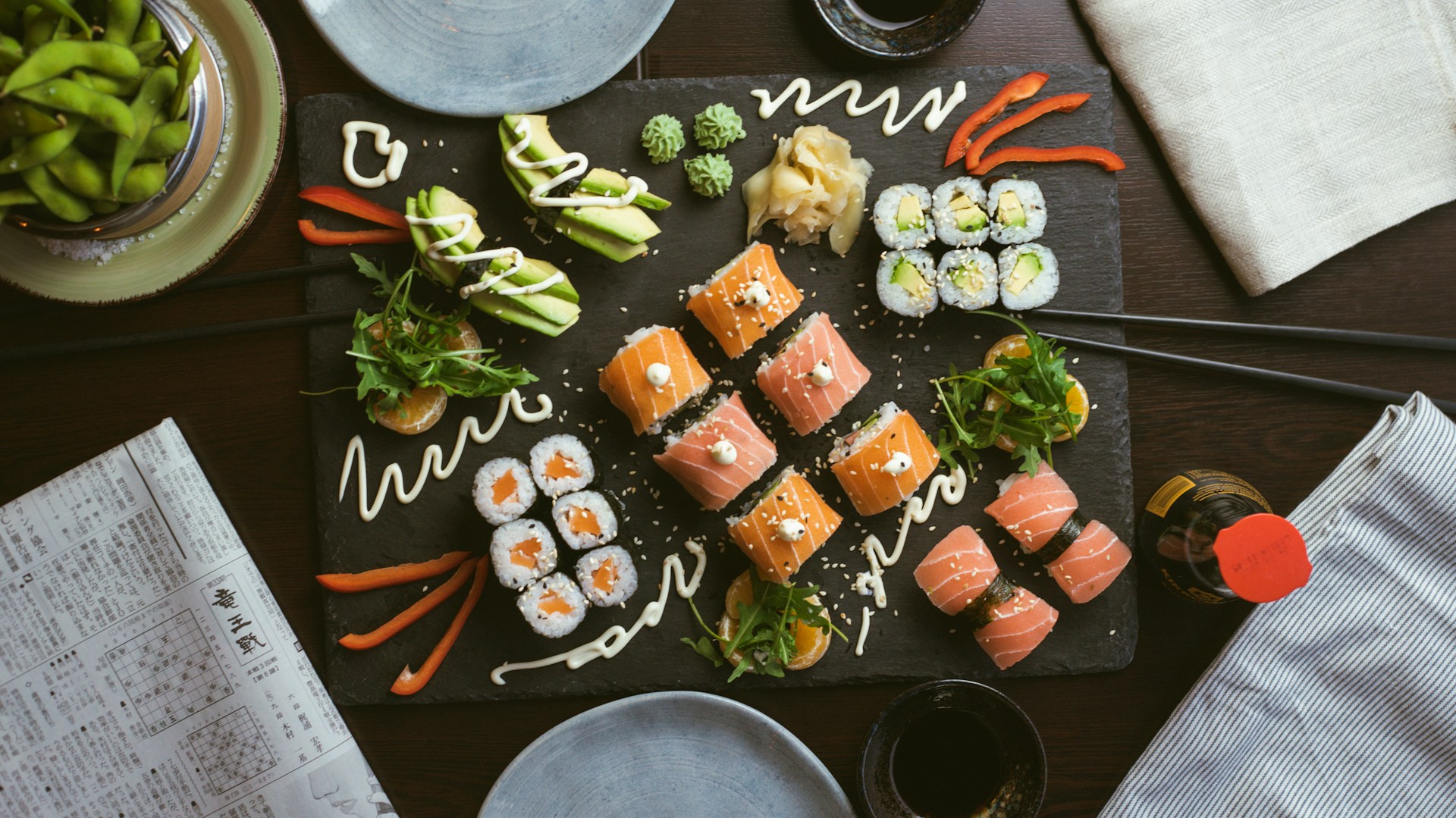Note that iPhone devices from Mainland China aren’t eSIM compatible. Also iPhone devices from Hong Kong and Macao aren’t compatible (except for iPhone 13 Mini, iPhone 12 Mini, iPhone SE 2020 and iPhone XS)
Japan is a food lover’s paradise, where every region boasts its own unique dishes, flavors, and culinary traditions. From the bustling streets of Tokyo to the vibrant markets of Fukuoka, Japan’s food scene offers a deliciously diverse array of experiences for every palate. Whether you’re craving fresh sushi from Tsukiji’s legendary fish market, savory ramen in Fukuoka’s cozy alleyways, or sweet treats in Kyoto, each bite tells a story of the country’s rich culture and history. In this guide, we’ll take you on a mouthwatering journey through Japan’s regional specialties, street food favorites, and the best spots to indulge in this gastronomic wonderland.
1. Sushi
Sushi is often the first thing that comes to mind when people think about popular Japanese cuisine. It’s a culinary art form that combines simplicity and precision, making it one of the “must-try Japanese meals” when visiting the country. At its core, sushi features vinegared rice paired with fresh ingredients like seafood, vegetables, or even egg. But there’s so much more to it than that.
Types of Sushi
- Nigiri: Hand-pressed rice topped with a slice of fish or seafood.
- Maki: Rolled sushi wrapped in nori (seaweed) with rice and fillings like tuna or cucumber.
- Temaki: Cone-shaped rolls, perfect for eating on the go.
- Oshi: Pressed sushi, a specialty of Osaka, where layers of rice and toppings are compacted into a rectangular shape.
What Makes Sushi Special in Japan?
In Japan, sushi isn’t just food; it’s an experience. From high-end omakase dining where a skilled chef crafts each piece right before your eyes to conveyor belt sushi restaurants offering affordable plates, there’s something for every budget. Even convenience stores sell surprisingly fresh sushi that’s perfect for a quick snack.
Eating sushi in Japan is an unforgettable experience—it’s not just about the taste but also the presentation, the atmosphere, and the respect for ingredients.
Tips for Enjoying Sushi
- Dip the fish side (not the rice) into soy sauce to avoid overpowering the delicate flavors.
- Try it with a touch of wasabi for a spicy kick, but don’t mix it directly into your soy sauce—it’s considered bad etiquette.
- Pair your sushi with pickled ginger to cleanse your palate between bites.
Whether you’re in Tokyo enjoying sushi at a bustling market or in a quiet countryside town, this dish is undoubtedly one of the best foods in Japan. Perfectly balancing taste, texture, and tradition, sushi is a true reflection of Japanese culture.
2. Ramen
Ramen is more than just a bowl of noodles in Japan—it’s an experience. This dish, which originally came from China, has become a cornerstone of Japanese cuisine, loved by both locals and visitors. The heart of ramen lies in its broth, which can range from light and salty to rich and creamy, depending on the style and region.
Types of Ramen Broths
- Shoyu (Soy Sauce): A classic, savory broth with a slightly tangy edge.
- Miso: Rich and hearty, often associated with Hokkaido.
- Tonkotsu (Pork Bone): Creamy and deeply flavorful, a specialty of Fukuoka.
- Shio (Salt): Light and delicate, perfect for showcasing the toppings.
Common Toppings
- Chashu (braised pork belly)
- Soft-boiled eggs with a gooey yolk
- Bamboo shoots
- Green onions
- Seaweed
Where to Enjoy Ramen?
- Local Ramen Shops: Tiny, often bustling spots where each bowl is crafted with care.
- Ramen Chains: Reliable and consistent, perfect for a quick meal.
- Ramen Festivals: A chance to try multiple regional varieties in one place.
Pro Tip: Don’t be shy about slurping your noodles—it’s not only acceptable but a sign you’re enjoying your meal!
Whether you’re in a small five-seater shop in Tokyo or enjoying a street-side stall in Fukuoka, ramen is a must-try dish that’ll leave you full and happy.
3. Udon
Udon is one of Japan’s most beloved noodle dishes, known for its thick, chewy texture and incredible versatility. Made from wheat flour, salt, and water, these noodles are a staple in Japanese cuisine. Whether you’re grabbing a quick bite during a lunch break or savoring a comforting meal at home, udon is a go-to option for many.
Popular Udon Styles
- Kake Udon: Served in a simple, light broth made from dashi, soy sauce, and mirin, topped with green onions.
- Kitsune Udon: Features fried tofu slices, adding a slightly sweet and savory twist.
- Curry Udon: Combines the richness of Japanese curry with the satisfying texture of udon noodles.
Why Udon is Special?
- Regional Variations: Every region in Japan has its own take on udon. For example, Sanuki udon from Kagawa Prefecture is famous for its firm texture.
- Hot or Cold: Udon can be enjoyed hot in a steaming broth during winter or cold with dipping sauce in summer.
- Quick and Accessible: Udon shops are everywhere in Japan, often offering fast service at affordable prices.
Udon isn’t just a dish—it’s an experience. From the first slurp to the last sip of broth, it’s a comforting hug in a bowl.
4. Okonomiyaki
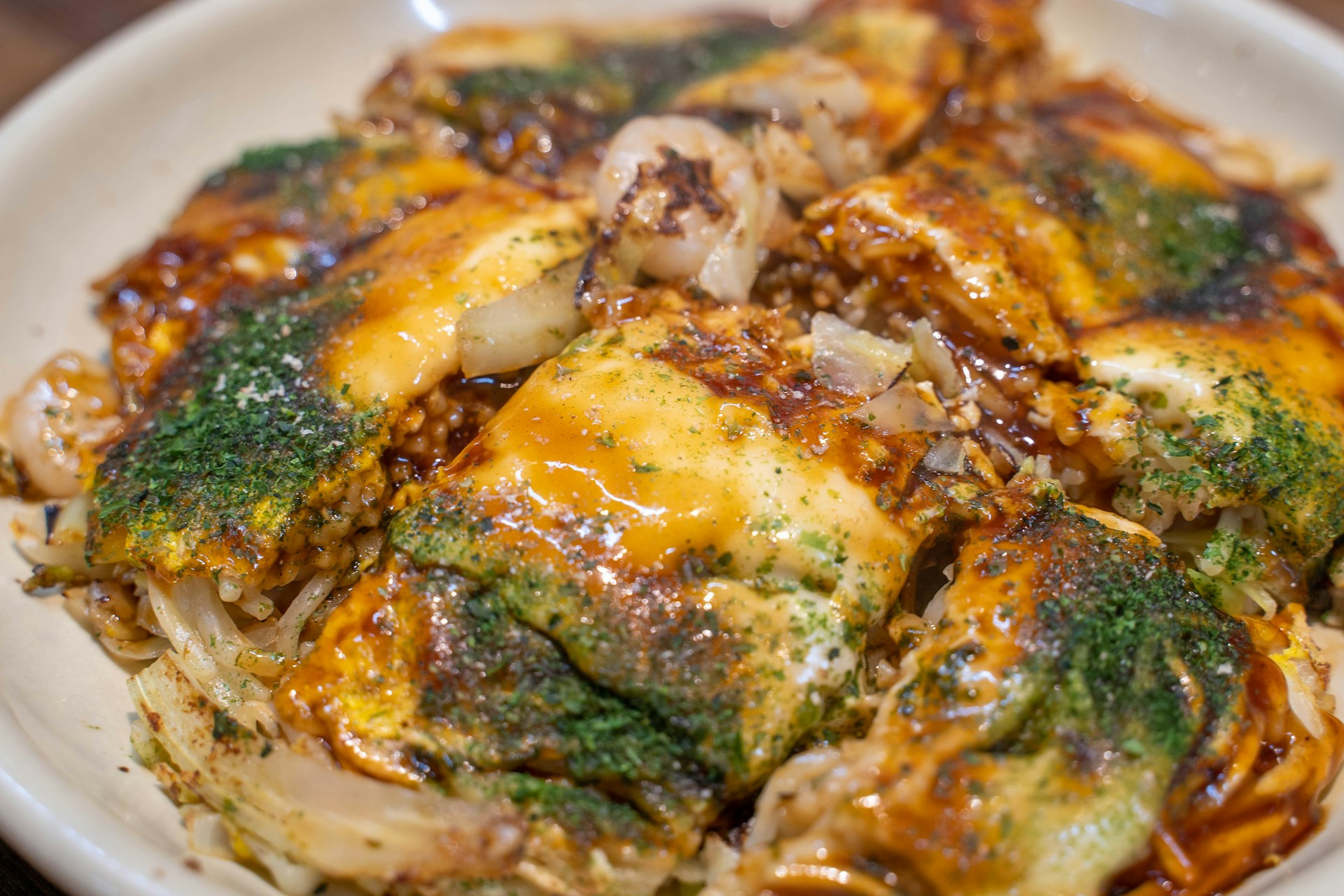
Okonomiyaki is often called Japan’s savory pancake, but that doesn’t quite do it justice. It’s a hearty dish that’s part comfort food, part culinary art. The name itself means “grilled as you like,” and that’s the magic of it—you can tailor it to fit your taste perfectly. This dish is a must-try if you’re visiting Japan, especially in Osaka, where it’s a local specialty.
What’s in It?
At its core, okonomiyaki starts with a batter made from flour, eggs, and shredded cabbage. After that, it’s a free-for-all. Here are some common ingredients:
- Protein options like pork belly, shrimp, or squid.
- Vegetables such as green onions or grated yam.
- Toppings like mayonnaise, okonomiyaki sauce (a tangy, Worcestershire-style sauce), dried seaweed, and katsuobushi (bonito flakes).
The Experience
One of the best parts about eating okonomiyaki is the experience itself. Many restaurants let you cook it yourself on a teppan (hotplate) built into your table. Not feeling confident? No worries—the staff is usually happy to help. It’s interactive, fun, and a great way to bond with friends or family over food.
Regional Variations
While Osaka is the birthplace of okonomiyaki, Hiroshima has its own twist. Hiroshima-style okonomiyaki layers the ingredients instead of mixing them and often includes noodles. It’s a bit more complex but equally delicious.
Pro Tip: If you’re traveling through Japan, make sure to try both Osaka and Hiroshima styles to see which one you prefer!
For expecting parents planning a babymoon in Japan, Kyoto’s cultural serenity offers a chance to enjoy okonomiyaki in a more traditional, relaxed setting. Pair it with a tranquil tea ceremony for a truly memorable experience.
Find Your Next Best Noodle Spot Online in Japan
Stay online in Japan with instant activation of your eSIM
5. Takoyaki
Takoyaki is one of Japan’s most iconic street foods, especially famous in Osaka, the culinary heart of the Kansai region. These little round snacks are made from a savory batter cooked in special griddles that give them their perfect spherical shape. Inside each ball lies a chewy piece of octopus (tako in Japanese), along with tempura scraps, pickled ginger, and scallions. The crispy exterior and molten, gooey center make them absolutely irresistible.
How to Enjoy Takoyaki?
- Toppings Matter: Traditional takoyaki is slathered with a sweet and tangy brown sauce (similar to Worcestershire), a generous drizzle of mayonnaise, and a sprinkling of bonito flakes that seem to dance from the heat.
- Perfect Pairings: Pair your takoyaki with an icy cold beer or a refreshing soda for the ultimate street food experience.
- Eat It Hot: Be careful, though—they’re served piping hot straight off the griddle, so take small bites to avoid burning your tongue!
Where to Find the Best Takoyaki?
- Osaka’s Dotonbori District: Known as the birthplace of takoyaki, this bustling area is home to countless stalls and shops serving up this beloved snack.
- Gindako: A popular chain known for its crispy-on-the-outside, creamy-on-the-inside takoyaki.
- Local Festivals: Keep an eye out for takoyaki stalls at Japanese festivals, where the atmosphere adds to the fun of enjoying this treat.
Takoyaki isn’t just food—it’s a quintessential part of Japanese street food culture and a must-try for anyone visiting Japan.
6. Sashimi
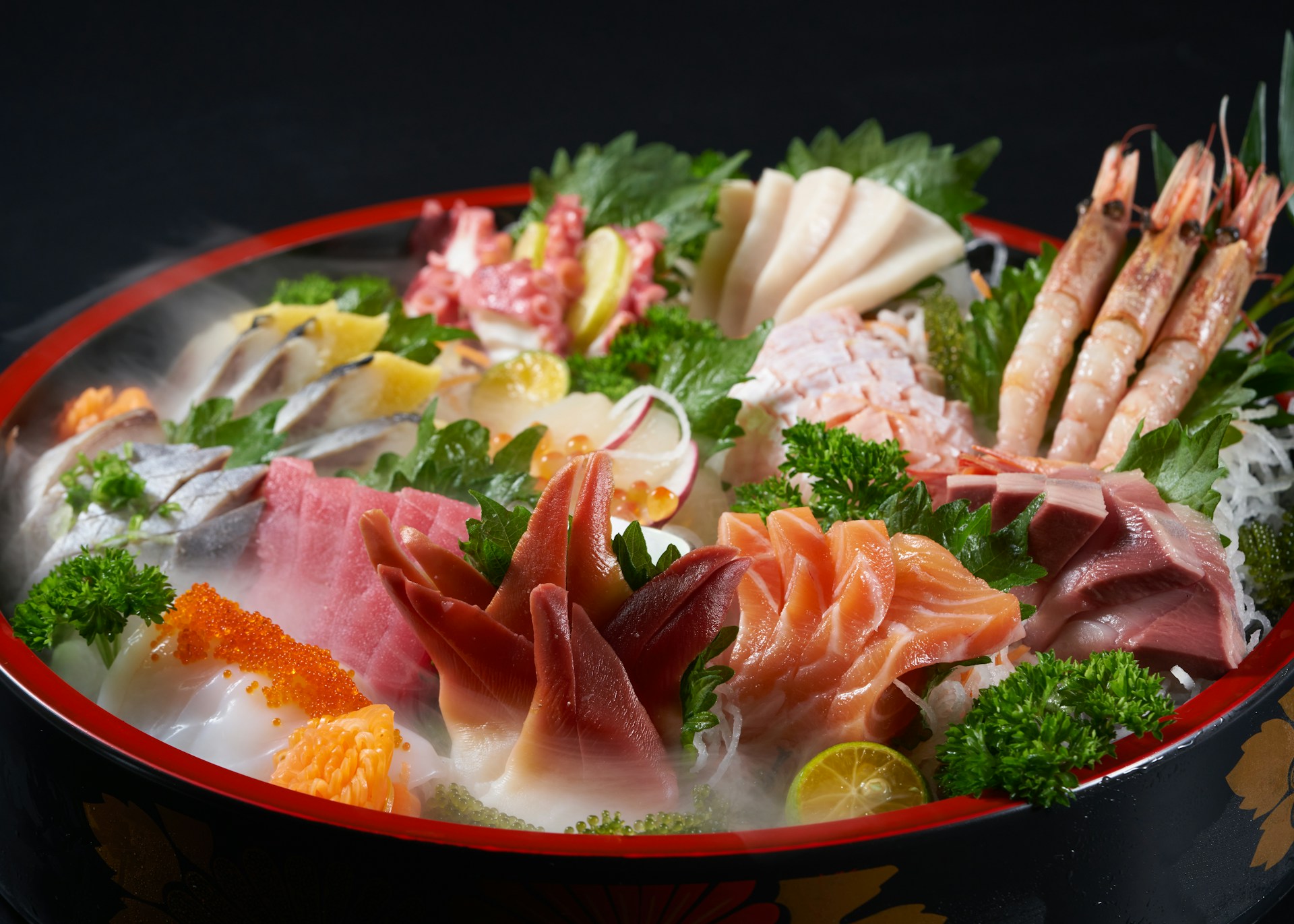
Sashimi is one of Japan’s most iconic dishes, celebrated for its simplicity and freshness. It consists of thinly sliced raw fish or seafood, often served with soy sauce and a dab of wasabi for a kick. What makes sashimi special is the incredible quality of the fish, which is so fresh it practically melts in your mouth.
Key Types of Sashimi
- Maguro (Tuna): A favorite for its rich flavor and versatility.
- Salmon: Known for its buttery texture and vibrant color.
- Hamachi (Yellowtail): A slightly fatty fish with a mild taste.
- Tako (Octopus): Chewy and mildly sweet.
- Uni (Sea Urchin): A creamy delicacy with a unique briny flavor.
The Art of Eating Sashimi
- Use chopsticks to gently pick up a slice.
- Dip lightly into soy sauce—don’t overdo it, as it can overpower the fish.
- Add a small amount of wasabi if you enjoy a spicy kick.
- Savor the pure, unadulterated taste of the seafood.
Where to Try the Best Sashimi in Japan?
- Tsukiji Outer Market, Tokyo: Famous for its fresh, high-quality sashimi.
- Local Izakayas: These casual pubs often serve excellent sashimi platters.
- High-End Sushi Restaurants: For a luxurious experience, try sashimi prepared by a master chef.
Eating sashimi in Japan is a must for seafood lovers. Each bite is a testament to the country’s dedication to freshness and quality. Whether you’re at a bustling market or a quiet restaurant, sashimi is bound to leave a lasting impression.
For travelers, staying connected in Japan is essential to share your culinary adventures. Consider affordable Japan eSIM plans from Voye Global to ensure seamless connectivity throughout your trip.
7. Tempura
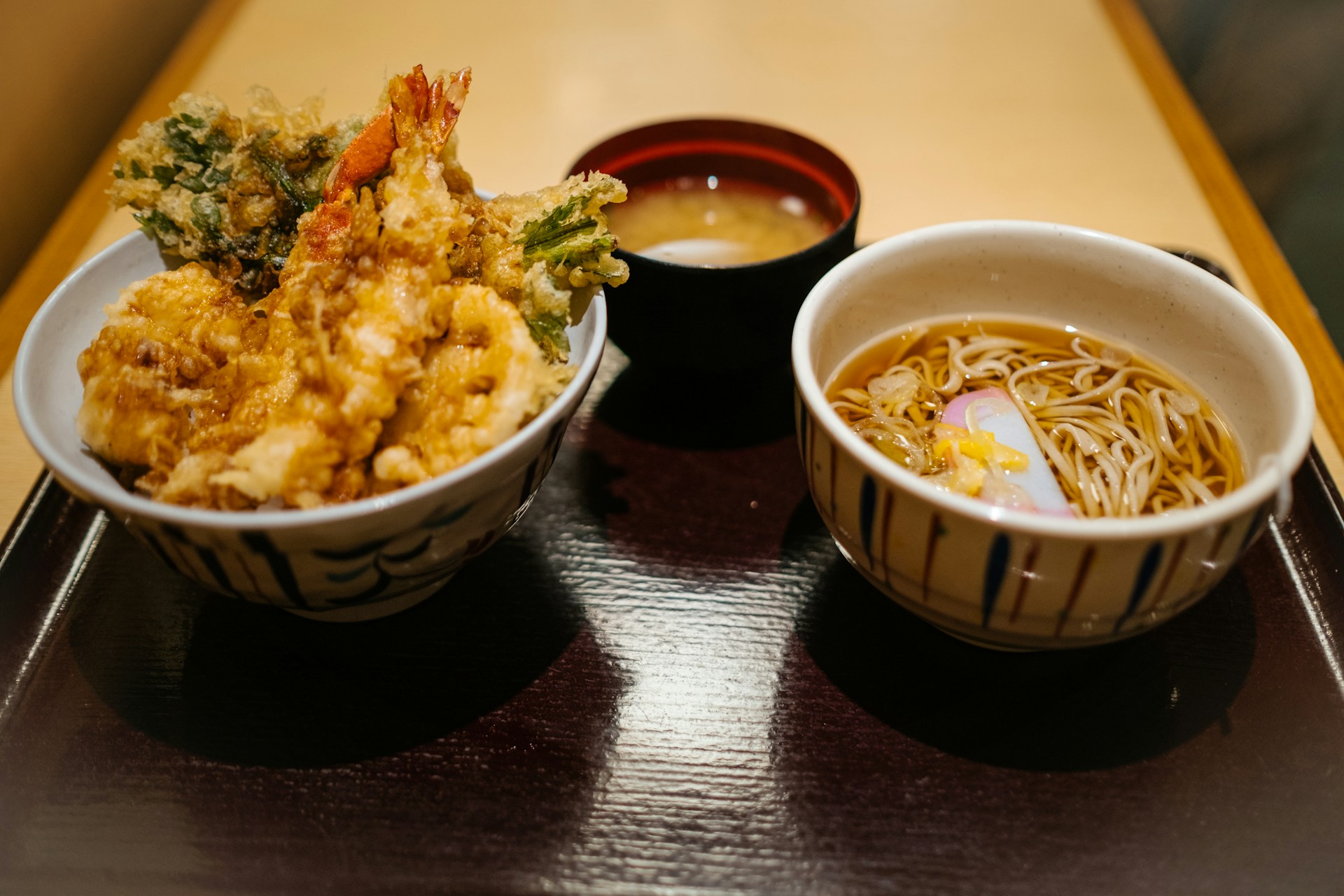
Tempura is one of the most iconic traditional Japanese dishes, offering a perfect balance of texture and flavor. This deep-fried delight is made by coating seafood, vegetables, or even meat in a light batter, then frying it until golden and crispy. What makes tempura stand out is its airy, non-greasy finish, which lets the natural flavors of the ingredients shine through.
Popular Ingredients in Tempura
- Prawns: A classic choice, known for their sweet and tender bite.
- Pumpkin: A seasonal favorite with a mildly sweet taste.
- Eggplant: Soft and creamy inside, with a crispy outer layer.
- Fish: Often white fish like cod, offering a flaky texture.
How to Enjoy Tempura?
- Dip your tempura into “tentsuyu” sauce, a savory blend of soy sauce, mirin, and dashi.
- Pair it with grated radish (daikon) for a refreshing contrast.
- Enjoy it as part of a tempura rice bowl or a multi-course meal.
Tempura is simple yet versatile, making it a must-try for anyone exploring Japan’s culinary treasures.
8. Tonkatsu
Tonkatsu is a beloved Japanese dish that brings together crispy textures and savory flavors. Breaded and deep-fried to golden perfection, this pork cutlet is a satisfying comfort food you’ll find everywhere from casual eateries to upscale restaurants. Typically made with either pork loin or fillet, the meat is coated in panko breadcrumbs, giving it that signature crunch.
What Makes Tonkatsu Special?
- The Sauce: Tonkatsu is often paired with a tangy, slightly sweet sauce made from fruits, vegetables, and spices. This sauce is drizzled generously over the cutlet or served on the side for dipping.
- The Sides: A typical Tonkatsu meal comes with a fresh mound of finely shredded cabbage, a bowl of steamed rice, and a side of miso soup. The cabbage adds a refreshing crunch that balances the richness of the pork.
- Regional Variations: In Nagoya, you might find “Miso Katsu,” where the cutlet is smothered in a rich, dark miso sauce. Meanwhile, in Kagoshima, the dish often uses kurobuta (Berkshire pork), known for its tender and juicy texture.
How to Enjoy Tonkatsu?
- Dip and Bite: Take a slice of Tonkatsu, dip it in the sauce, and savor the blend of crispy coating and juicy pork.
- Try Katsudon: This variation serves Tonkatsu over a bowl of rice, topped with a savory egg mixture. It’s hearty and perfect for a quick meal.
- Pair it Right: Tonkatsu pairs beautifully with a cold glass of Japanese beer or green tea for a complete experience.
A plate of Tonkatsu isn’t just food—it’s a celebration of balance. The crispy crust, tender meat, and refreshing sides come together to create a meal that’s both comforting and unforgettable.
For travelers, Tonkatsu is a must-try dish that showcases Japan’s knack for turning simple ingredients into something extraordinary.
9. Onigiri
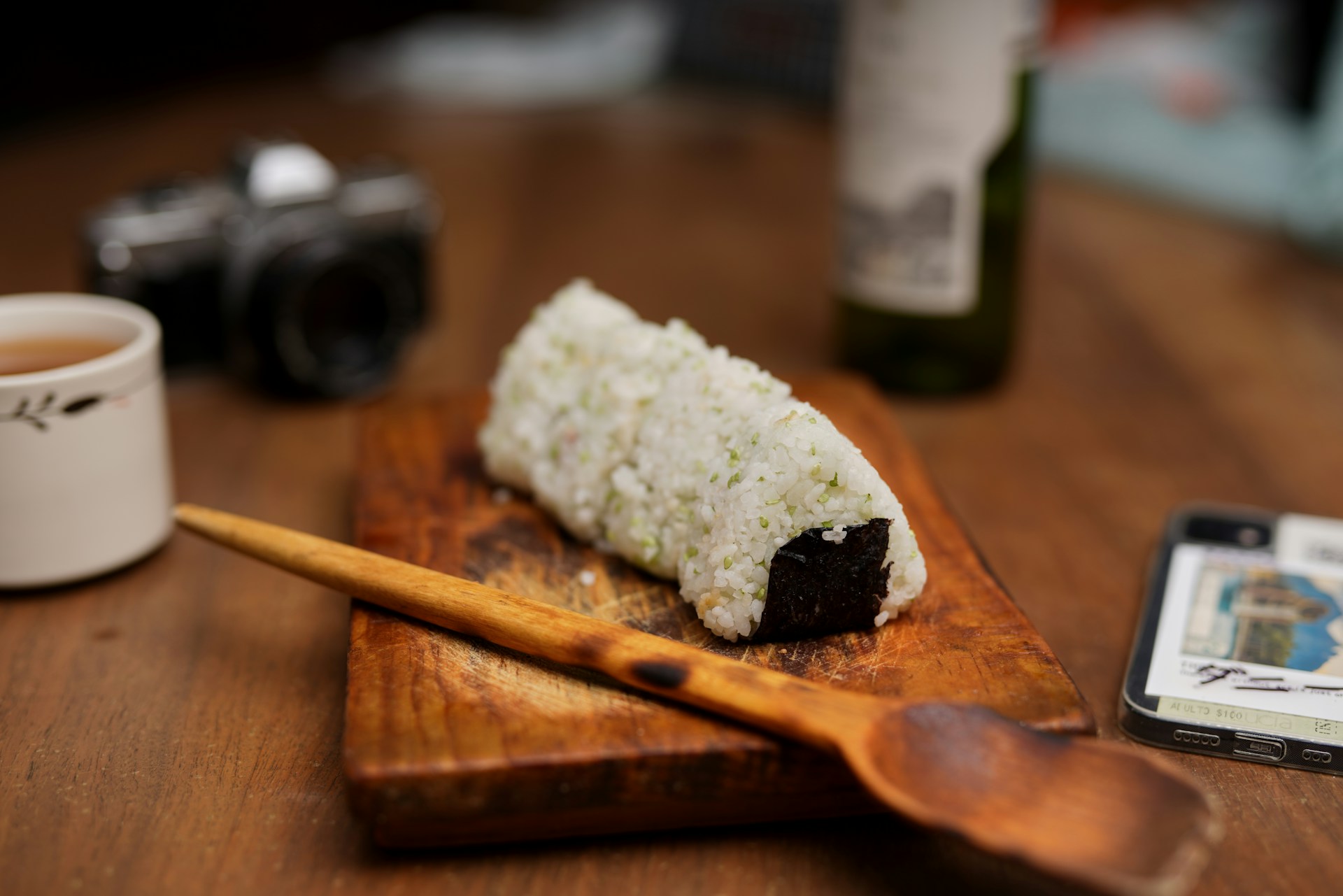
Onigiri, or Japanese rice balls, are a staple snack that you’ll find everywhere in Japan. It’s the go-to option when you’re hungry and need something quick and satisfying. These little bundles of rice are seasoned or filled with a variety of ingredients, making them as versatile as they are delicious. Wrapped in a sheet of nori (seaweed), they’re not only convenient but also packed with flavor.
Common Fillings and Flavors
- Salmon (Sake): A classic choice, with a savory and slightly smoky flavor.
- Pickled Plum (Umeboshi): Tart and salty, this one’s for adventurous palates.
- Tuna Mayo: Creamy and rich, a modern favorite.
- Konbu: Simmered seaweed with a sweet and salty taste.
Where to Find Onigiri?
- Convenience Stores (Konbini): Places like 7-Eleven, Lawson, and FamilyMart stock a wide variety of onigiri, often freshly made.
- Specialty Shops: Some stores focus solely on crafting onigiri, offering unique fillings and premium ingredients.
- Supermarkets: A budget-friendly option with plenty of choices.
Onigiri isn’t just food—it’s a piece of Japanese culture. Whether you’re grabbing one on the go or enjoying it as part of a picnic, it’s a simple delight that never disappoints.
10. Miso Soup

Miso soup is a cornerstone of Japanese cuisine, appearing at nearly every meal as a comforting side dish. This humble soup packs a punch of umami flavor, thanks to its base of miso paste—made from fermented soybeans—and dashi, a traditional Japanese stock. It’s not just about the broth, though. Classic miso soup often includes tofu cubes, green onions, and wakame seaweed, and may also feature seasonal vegetables like carrots or sweet potatoes.
Variations Across Japan
- Red Miso: Particularly popular in Nagoya, this variety has a deeper, richer flavor and is sometimes used in hearty dishes.
- White Miso: Sweeter and milder, this is a favorite in Kyoto, often paired with delicate ingredients.
- Mixed Miso: A blend of red and white, offering a balanced flavor profile.
How to Enjoy It?
- Always served as a side dish, miso soup pairs beautifully with steamed rice.
- Add a dash of chili oil or sesame seeds for a modern twist.
- Try it with a serving of Japanese pickles (tsukemono) for a full traditional experience.
A warm bowl of miso soup is more than just food—it’s a reminder of the simple joys in Japanese dining. Whether you’re exploring bustling Tokyo or a quiet Kyoto inn, this soup is a constant companion, offering both nourishment and comfort.
Miso soup is a warm and comforting dish that many people enjoy. It’s made with a tasty broth called dashi and mixed with miso paste, which gives it a unique flavor. You can add ingredients like tofu, seaweed, and green onions to make it even better.
There You Have It!
Exploring Japan through its food is like taking a journey through its culture, history, and traditions. From the sizzling street food stalls to the refined art of sushi, every bite tells a story. Whether you’re slurping ramen in a bustling city or savoring fresh sashimi by the coast, there’s something magical about the flavors of Japan. So, pack your appetite and let your taste buds guide you—because in Japan, every meal is an adventure waiting to be discovered.
Seamless Mobile Data Everywhere







